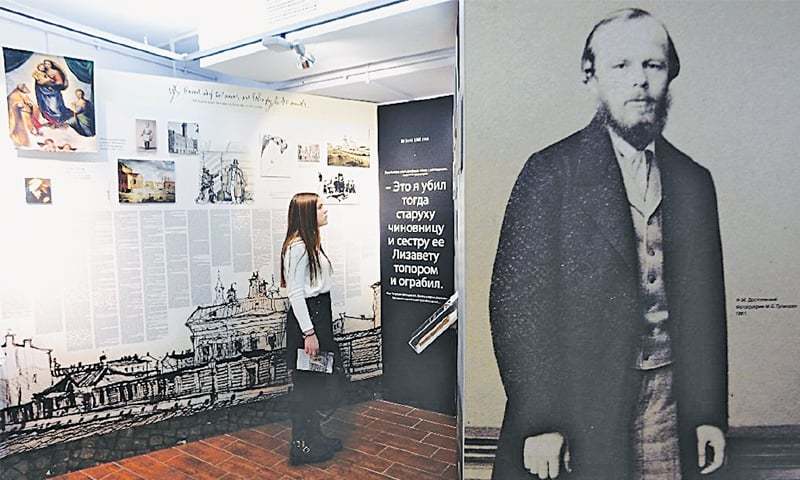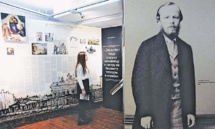Entering the museum, the visitor is literally immersed in the novel whose full text is plastered over the walls, vying for space with an array of paintings, sketches, documents and antiques from 19th century Saint Petersburg where the story is set.
First published in serial form in a literary journal, "Crime and Punishment" tells the story of Rodion Raskolnikov, an impoverished young man who believes himself morally superior to everyone else and tries to test the limits of his freedom by murdering an elderly pawnbroker.
He is then tormented by his actions, with the novel exploring themes such as the legitimacy of violence, the limits of freedom and the price of human life -- quintessential hallmarks of Dostoyevsky's works and of Russian literature as a whole.
Translated into multiple languages and adapted for the silver screen in a string of countries, "Crime and Punishment" is a literary masterpiece which ranks alongside other classics of Russian literature such as Leo Tolstoy's "War and Peace" (1869) or works by Pushkin and Gogol.
"You really get the impression you are submerged in the novel," said 33-year-old Roman Kovchenko as he visited the exhibition with his mother.
"This is my favourite Dostoyevsky novel, it's the most 'Saint-Petersburg'," enthuses another visitor, says 45-year-old Galina Somova who says it holds a particular fascination for residents of the city.
"For those who love the novel, who have read it many times, discovering new details or nuances and comparing your imagination with that of the organisers is very interesting," she told AFP.
- 'Three-dimensional' exhibit -
According to the organisers, the exhibit showcases "three dimensions" of Dostoyevsky's complex work: the first representing the pre-revolutionary Saint Petersburg itself, the rich architecture of its houses and courtyards, its taverns and winding canals and taverns which are illustrated by paintings or photos from the era.
The second dimension throws light on the era in which the novel is set through objects linked to the plot. In addition to paintings and archive pictures of Russia's old capital, the exhibition showcases everyday items and documents which shed light on daily life in 19th century Saint Petersburg.
One unusual item on display is a "yellow ticket" -- an informal identification card given to prostitutes in an allusion to the profession of Sonya, one of the heroines who falls in love with Raskolnikov and moves across the vast Russian empire to be with him.
Visitors can also see a reconstruction of the room where the pawnbroker is killed, filled with gold ornaments and other objects mentioned in the text, among them a silver watch.
The third dimension is that of philosophy and religion, with images reflecting everything from the biblical themes of last judgment to the resurrection of Lazarus -- elements which are central to the writings of Dostoyevsky, a devout Christian.
"Dostoyevsky wanted 'to pose all the questions' in his novel and that's exactly the idea of our exhibition, which reflects several aspects of this work," explained Natalya Ashimbayeva, director of Saint Petersburg's Dostoyevsky Museum which is hosting the exhibit.
"This novel is a boundless source of knowledge about Dostoyevsky's ideas," she said.
----------------------------------------------------------------------------------------------------------------
First published in serial form in a literary journal, "Crime and Punishment" tells the story of Rodion Raskolnikov, an impoverished young man who believes himself morally superior to everyone else and tries to test the limits of his freedom by murdering an elderly pawnbroker.
He is then tormented by his actions, with the novel exploring themes such as the legitimacy of violence, the limits of freedom and the price of human life -- quintessential hallmarks of Dostoyevsky's works and of Russian literature as a whole.
Translated into multiple languages and adapted for the silver screen in a string of countries, "Crime and Punishment" is a literary masterpiece which ranks alongside other classics of Russian literature such as Leo Tolstoy's "War and Peace" (1869) or works by Pushkin and Gogol.
"You really get the impression you are submerged in the novel," said 33-year-old Roman Kovchenko as he visited the exhibition with his mother.
"This is my favourite Dostoyevsky novel, it's the most 'Saint-Petersburg'," enthuses another visitor, says 45-year-old Galina Somova who says it holds a particular fascination for residents of the city.
"For those who love the novel, who have read it many times, discovering new details or nuances and comparing your imagination with that of the organisers is very interesting," she told AFP.
- 'Three-dimensional' exhibit -
According to the organisers, the exhibit showcases "three dimensions" of Dostoyevsky's complex work: the first representing the pre-revolutionary Saint Petersburg itself, the rich architecture of its houses and courtyards, its taverns and winding canals and taverns which are illustrated by paintings or photos from the era.
The second dimension throws light on the era in which the novel is set through objects linked to the plot. In addition to paintings and archive pictures of Russia's old capital, the exhibition showcases everyday items and documents which shed light on daily life in 19th century Saint Petersburg.
One unusual item on display is a "yellow ticket" -- an informal identification card given to prostitutes in an allusion to the profession of Sonya, one of the heroines who falls in love with Raskolnikov and moves across the vast Russian empire to be with him.
Visitors can also see a reconstruction of the room where the pawnbroker is killed, filled with gold ornaments and other objects mentioned in the text, among them a silver watch.
The third dimension is that of philosophy and religion, with images reflecting everything from the biblical themes of last judgment to the resurrection of Lazarus -- elements which are central to the writings of Dostoyevsky, a devout Christian.
"Dostoyevsky wanted 'to pose all the questions' in his novel and that's exactly the idea of our exhibition, which reflects several aspects of this work," explained Natalya Ashimbayeva, director of Saint Petersburg's Dostoyevsky Museum which is hosting the exhibit.
"This novel is a boundless source of knowledge about Dostoyevsky's ideas," she said.
----------------------------------------------------------------------------------------------------------------









 Home
Home Politics
Politics











